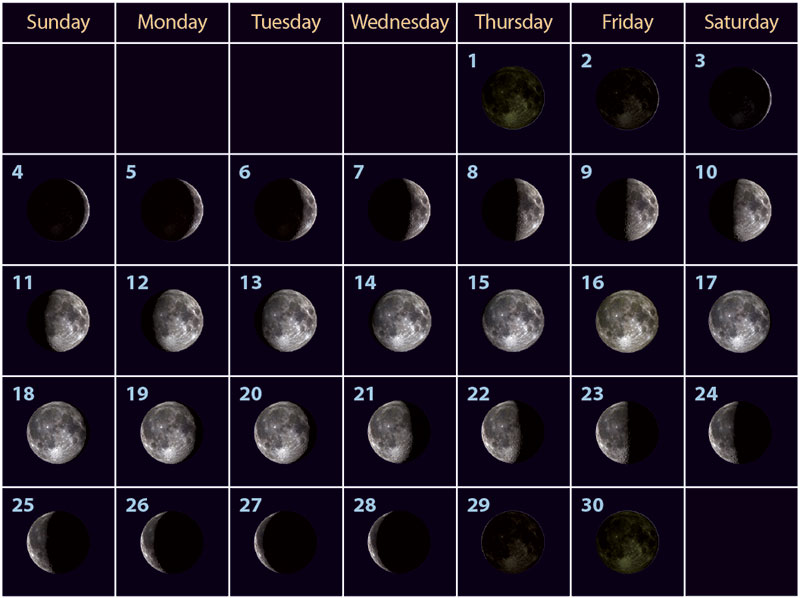
After the Sun, the Moon is the next brightest and most noticeable object in our sky. Of course, the difference in brightness between the Sun and Moon is huge — that’s why it’s pretty dark at night even when the Moon is out. Moreover, while the Sun always looks essentially the same in our sky, the Moon appears to change its shape from day to day in what we call the Moon’s cycle of phases. In this section, we will explore why we see the Moon go through its phases, as well as the rarer but spectacular events called eclipses.
Incidentally, you’ll notice in Figure 2.22 that the 29 ½ days that it takes for the Moon to go through a full cycle of phases is very close to a month. This is not a coincidence: The word month (think “moonth”) actually comes from the Moon’s cycle of phases.
Section Learning Goals
By the end of this section, you should be able to answer the following questions:
- Why do we see phases of the Moon?
- When do we see different phases of the Moon in our sky?
- Why do we always see the same face of the Moon?
- What are eclipses?
Before you continue, take a few minutes to discuss the above Learning Goal questions in small groups or as a class. For example, you might discuss what (if anything) you already know about the answers to these questions; what you think you’ll need to learn in order to be able to answer the questions; and whether there are any aspects of the questions, or other related questions, that you are particularly interested in.
Group Discussion
Phases of the Moon
Working as a group, do your best to answer the following questions. Don’t worry if you don’t know all the answers; you’ll learn the correct answers later in this section.
- Compare the phases you see in Figure 2.22 to the daily Moon phase sketches you’ve been making in your journal. Can you see the correspondence?
- What are the names of the phases shown in Figure 2.22?
- Why do we see the Moon go through phases? Do the phases have anything to do with shadows from Earth?
- Does Earth ever cast a shadow on the Moon? If so, when?
Teacher Notes: Students have in principle learned about lunar phases in elementary school, but you can use this discussion to get a sense of how much they remember or understand. We recommend starting this discussion as a full class, but then splitting into smaller groups at question 3, as noted below. Specific notes:
- (1) This first question assumes that students have been making daily observations of the Moon for the journal activity at the start of this chapter. They can compare each others’ entries, and make sure that they see the correspondence with the Moon phase progression shown in Figure 2.22.
- (2) You might do this as a class and see how many of the phases they can name, and if they can distinguish between waxing and waning phases.
- (3) For this question, you might wish to break the class into smaller groups to see if they can come up with the correct answer for the cause of the phases, and the fact that the phases have nothing to do with shadows from Earth. If they don’t know the correct answers, for now just help them think about what might be right or wrong in their guesses, so they are ready to learn the correct answers in Section 2.3.1.
- (4) During eclipses. The key point here is to make sure students know that while Earth’s shadow is not involved in phases, it does come into play with eclipses.